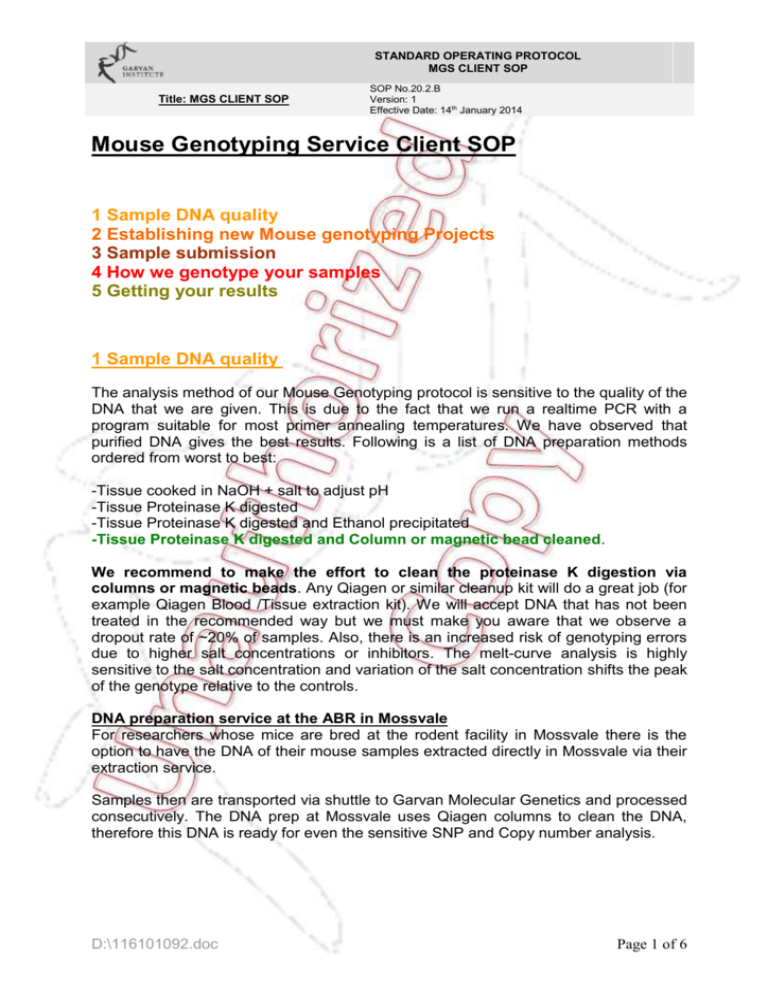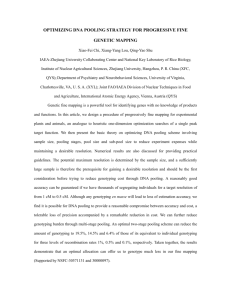Mouse Genotyping Service Client SOP
advertisement

STANDARD OPERATING PROTOCOL MGS CLIENT SOP Title: MGS CLIENT SOP SOP No.20.2.B Version: 1 Effective Date: 14th January 2014 Mouse Genotyping Service Client SOP 1 Sample DNA quality 2 Establishing new Mouse genotyping Projects 3 Sample submission 4 How we genotype your samples 5 Getting your results 1 Sample DNA quality The analysis method of our Mouse Genotyping protocol is sensitive to the quality of the DNA that we are given. This is due to the fact that we run a realtime PCR with a program suitable for most primer annealing temperatures. We have observed that purified DNA gives the best results. Following is a list of DNA preparation methods ordered from worst to best: -Tissue cooked in NaOH + salt to adjust pH -Tissue Proteinase K digested -Tissue Proteinase K digested and Ethanol precipitated -Tissue Proteinase K digested and Column or magnetic bead cleaned. We recommend to make the effort to clean the proteinase K digestion via columns or magnetic beads. Any Qiagen or similar cleanup kit will do a great job (for example Qiagen Blood /Tissue extraction kit). We will accept DNA that has not been treated in the recommended way but we must make you aware that we observe a dropout rate of ~20% of samples. Also, there is an increased risk of genotyping errors due to higher salt concentrations or inhibitors. The melt-curve analysis is highly sensitive to the salt concentration and variation of the salt concentration shifts the peak of the genotype relative to the controls. DNA preparation service at the ABR in Mossvale For researchers whose mice are bred at the rodent facility in Mossvale there is the option to have the DNA of their mouse samples extracted directly in Mossvale via their extraction service. Samples then are transported via shuttle to Garvan Molecular Genetics and processed consecutively. The DNA prep at Mossvale uses Qiagen columns to clean the DNA, therefore this DNA is ready for even the sensitive SNP and Copy number analysis. D:\116101092.doc Page 1 of 6 STANDARD OPERATING PROTOCOL MGS CLIENT SOP Title: MGS CLIENT SOP SOP No.20.2.B Version: 1 Effective Date: 14th January 2014 2 Establishing new Mouse genotyping Projects We are happy to establish all kind of new mouse genotyping projects from you. Currently we do not charge any establishing fees. We just need some information and a little patience from you. When you want us to establish a new protocol we ask you to fill in a document that we call Project-Template document. This template doc can be downloaded from our intranet webpage. Please fill in whom to report to, the gene name, the primer sequences, the primer combinations & product sizes, and expected genotypes (eg wildtype, heterozygous, homozygous). We will need some controls (HET, WT, HOM) to get us started. These controls can be samples that have been genotyped and confirmed for their genotype before. We will order the primers and once they have arrived we will establish the project. In case you only have a gene name or sequence we can design primers too. Once primers have arrived (usually 4 days) we will establish the project with our genotyping protocol. We then will be in contact with you and inform you about the progress. In case time matters and you need us to establish your project very quickly, you can provide us with primer aliquots and we will start immediately to establish the project. 3 Sample submission How? For routine genotyping we prefer samples to be in a 96well format as these plates fit to our robot liquid handlers. These fully skirted 96 well PCR plates incl. seals can be purchased through us or via Biorad directly (Biorad plates HSP-9901 & Microseals PCR MSB-1001). Additional positive controls Some researchers prefer to add positive controls to each plate they are sending to us and for each test they want us to perform. We greatly appreciate this as it adds additional safety to the tests. If you can, please add positive and negative controls to your sample submission plate. Where? Personal Sample Delivery The sample 96well plate for genotyping can be placed into the second shelf of the “Mouse genotyping reception fridge” which is located on level8 in lab 8.01 in the fridge with the asset number 5155. There is a reception tray in the fridge clearly marked. Please place your samples here and send an accompanying email with the sample submission form to gmg@garvan.org.au Sample submission via ABR in Mossvale D:\116101092.doc Page 2 of 6 STANDARD OPERATING PROTOCOL MGS CLIENT SOP Title: MGS CLIENT SOP SOP No.20.2.B Version: 1 Effective Date: 14th January 2014 Talk to Kevin Taylor in Mossvale to arrange for your samples to be processed in Mossvale and sent directly via shuttle, no further action required on your side. Phone: 02 9295 8596, email: k.taylor@garvan.org.au Sample submission via Australian Post You can also keep your samples dried down after Ethanol precipitation and send the plate via Australian post to: Garvan Molecular Genetics The Garvan Institute of Medical Research Level 8, 384 Victoria Street Darlinghurst, NSW, 2010 Sample Submission form Please accompany your samples with a form that tells us what sample is where and needs what genotyping. You can use the Sample submission form which can be downloaded from our intranet page. This is how the form looks like: This form should be sent via email to gmg@garvan.org.au How much? The volume of the sample DNA should be at least 30ul in each well of the 96well plate. We will not need that much DNA, we will most likely only use 1ul of this DNA but D:\116101092.doc Page 3 of 6 STANDARD OPERATING PROTOCOL MGS CLIENT SOP Title: MGS CLIENT SOP SOP No.20.2.B Version: 1 Effective Date: 14th January 2014 we need this volume for the robotic liquid handlers to safely operate. Ideally you would have 10ng/ul concentration of your submitted DNA but we accept anything between 5ng/ul to 100ng/ul. How do I get my DNA back? After genotyping results have been sent you can pick up the remaining DNA from the sample reception fridge if you needed the samples for further testing. We will keep these samples for 3 weeks after the results have been sent to you. After 3 weeks we will discard the samples without further notification, assuming you do not need the samples any longer as our storage capacity is limited. 4 How we genotype your sample We perform a touchdown realtime PCR in a 384well plate scale. Samples are processed via liquid handlers and analysed on our LightCycler 480 with a Sito9-based Meltcurve analysis. The control meltcurve peaks are compared to the sample peaks. The test format is also used by the Jackson Laboratories in the USA. We run positive and negative controls for each test and only release results when all controls have worked. Here is an example of a typical meltcurve analysis: Neo positive Neo negative nen negative As you can see in the meltcurve plot there is one Neo negative sample, which has a slightly shifted peak. This is due to excessive salt in the DNA sample and a good example why cleaning up the DNA sample after proteinase K digestion is so important. 5 Getting your results D:\116101092.doc Page 4 of 6 STANDARD OPERATING PROTOCOL MGS CLIENT SOP Title: MGS CLIENT SOP SOP No.20.2.B Version: 1 Effective Date: 14th January 2014 How? The results of the genotyping will be sent to you via e-mail in a result document: How long? We usually complete the genotyping within 48 – 72 hours after sample reception. In case we have dropouts we will repeat them once. If they still do not come up we will inform you about the problem. In exceptional cases the genotyping might be delayed by a day or 2 if instruments are out of order or staff is sick. You can also label your samples as urgent and we will make a special effort to process them ASAP. Samples can be analysed with highest priority within 8h after reception. 6 Additional services Copy number analysis (Het/Hom differentiation) When exactly the same amount of DNA is added into a PCR reaction and the amplification process monitored via realtime PCR a homozygous sample will have a crossing point exactly one cycle earlier than a heterozygous sample. Therefore we can distinguish heterozygous samples from homozygous samples for any given gene by this protocol. For the method to work we quantify the DNA exactly, dilute to the same concentration and set up 5 PCRs (repetitions) of each sample and 2 house keeper genes, amplify in realtime mode and form the average Ct value for each sample, subtract the house keeper and compare to controls. This test only works with very clean DNA and a het and hom control. SNP analysis We have developed a reliable and very price competitive method to type SNPs in a high-throughput format. D:\116101092.doc Page 5 of 6 STANDARD OPERATING PROTOCOL MGS CLIENT SOP Title: MGS CLIENT SOP SOP No.20.2.B Version: 1 Effective Date: 14th January 2014 Mouse SNP panel for genetic monitoring of inbred strains We also offer a 28 SNP panel for quality controlling your inbred mouse lines routinely. The panel assesses genetic contamination in colonies containing a large number of genetically diverse mouse strains. This test is used by the Jackson Laboratory for their mouse lines and investigates 28 relevant loci which cover over 300 inbred, wildderived, congenic, consomic and recombinant inbred strains. Garvan Molecular Genetics The Garvan Institute of Medical Research Level 8 384 Victoria Street Darlinghurst NSW 2010 Phone: +61-2-9295 8384 Email gmg@garvan.org.au Web: www.garvan.org.au Pavel Bitter (Molecular Genetics Facility Manager) p.bitter@garvan.org.au D:\116101092.doc Page 6 of 6





